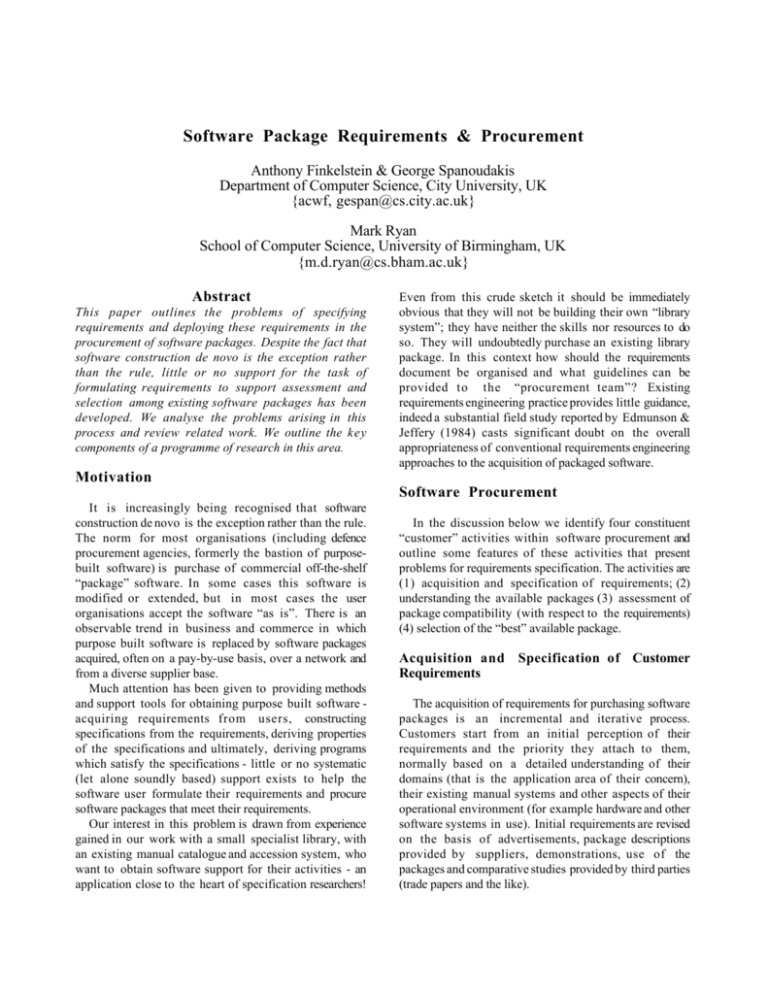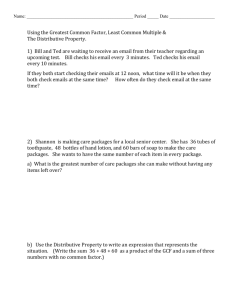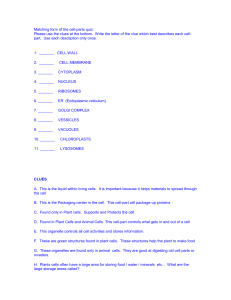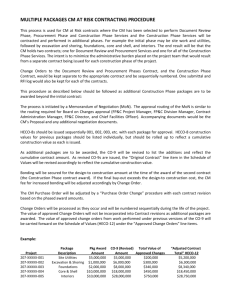Software Package Requirements & Procurement
advertisement

Software Package Requirements & Procurement
Anthony Finkelstein & George Spanoudakis
Department of Computer Science, City University, UK
{acwf, gespan@cs.city.ac.uk}
Mark Ryan
School of Computer Science, University of Birmingham, UK
{m.d.ryan@cs.bham.ac.uk}
Abstract
This paper outlines the problems of specifying
requirements and deploying these requirements in the
procurement of software packages. Despite the fact that
software construction de novo is the exception rather
than the rule, little or no support for the task of
formulating requirements to support assessment and
selection among existing software packages has been
developed. We analyse the problems arising in this
process and review related work. We outline the key
components of a programme of research in this area.
Even from this crude sketch it should be immediately
obvious that they will not be building their own “library
system”; they have neither the skills nor resources to do
so. They will undoubtedly purchase an existing library
package. In this context how should the requirements
document be organised and what guidelines can be
provided to the “procurement team”? Existing
requirements engineering practice provides little guidance,
indeed a substantial field study reported by Edmunson &
Jeffery (1984) casts significant doubt on the overall
appropriateness of conventional requirements engineering
approaches to the acquisition of packaged software.
Motivation
Software Procurement
It is increasingly being recognised that software
construction de novo is the exception rather than the rule.
The norm for most organisations (including defence
procurement agencies, formerly the bastion of purposebuilt software) is purchase of commercial off-the-shelf
“package” software. In some cases this software is
modified or extended, but in most cases the user
organisations accept the software “as is”. There is an
observable trend in business and commerce in which
purpose built software is replaced by software packages
acquired, often on a pay-by-use basis, over a network and
from a diverse supplier base.
Much attention has been given to providing methods
and support tools for obtaining purpose built software acquiring requirements from users, constructing
specifications from the requirements, deriving properties
of the specifications and ultimately, deriving programs
which satisfy the specifications - little or no systematic
(let alone soundly based) support exists to help the
software user formulate their requirements and procure
software packages that meet their requirements.
Our interest in this problem is drawn from experience
gained in our work with a small specialist library, with
an existing manual catalogue and accession system, who
want to obtain software support for their activities - an
application close to the heart of specification researchers!
In the discussion below we identify four constituent
“customer” activities within software procurement and
outline some features of these activities that present
problems for requirements specification. The activities are
(1) acquisition and specification of requirements; (2)
understanding the available packages (3) assessment of
package compatibility (with respect to the requirements)
(4) selection of the “best” available package.
Acquisition and Specification of Customer
Requirements
The acquisition of requirements for purchasing software
packages is an incremental and iterative process.
Customers start from an initial perception of their
requirements and the priority they attach to them,
normally based on a detailed understanding of their
domains (that is the application area of their concern),
their existing manual systems and other aspects of their
operational environment (for example hardware and other
software systems in use). Initial requirements are revised
on the basis of advertisements, package descriptions
provided by suppliers, demonstrations, use of the
packages and comparative studies provided by third parties
(trade papers and the like).
At an early stage in this process a distinction has to be
made between “core” requirements that is those
requirements which we can safely assume are provided by
all or most of the available packages (such as logging of
borrowing transactions in a library) and those “peripheral”
requirements which are very specific to the customer
(such as a library containing books with titles having
Hebrew or Cyrillic characters). The manner in which this
distinction is made shapes the procurement process, core
requirements are neglected, as they do not help to
distinguish between packages, while peripheral
requirements are emphasised.
In general, packages have some features which are
relevant to customer's needs and others which are not (for
example, the ability of a package to catalogue pictures in
a library which only has documents). Of course customers
may recognise new requirements in features, which
become very attractive once demonstrated but were not
perceived as requirements initially (an example might be
the ability to add descriptors to the catalogue entries for
photographs). Interdependencies between requirements are
often only appreciated as the range of features available
becomes apparent (in a library system the way in which
foreign language text is stored is closely linked to the
way in which the thesaurus is constructed).
Understanding Available Packages
Because packages are supplied by different vendors for
different, though intersecting, markets they are described
differently. The descriptions use a mixture of technical
and application domain specific terms, dependent on the
speciality or the emphasis of different vendors. Under
such circumstances, extracting information about, and
understanding the package is a very difficult task.
Understanding a package demands a translation between
two types of vocabularies, the vocabularies of various
package specifications (Pi) and the vocabulary of the
customer's requirements specification (R). These
translations may be thought of as morphisms from the
vocabularies of Pis to the vocabulary of R, which may
not be total, onto and isomorphic. In fact, there may be
features of packages wholly irrelevant to customer's
requirements, requirements not satisfied by some
packages, requirements satisfied through a synergy of
more than one package features and more than one
requirements satisfied by the same package feature.
In certain cases, especially if the package to be bought
is expensive, the translation may result from a
cooperation among the customer and the vendors. In this
setting the customer issues a request for proposal (RFP),
which enables vendors to describe their packages in a
uniform manner that is, in terms of the RFP. Of course
this process violates some of the “incrementality”
discussed above. Further, experience suggests that the
common response to an RFP is simply the standard
package description! In most cases the onus for
understanding packages rests with the prospective
customer.
Assessment of Package Compatibility
Customers have to assess the extent to which different
packages satisfy their requirements. Although in some
cases the satisfaction of a requirement admits a binary
answer (for example portability of a package onto a
particular platform without alteration), for most
requirements, different degrees of satisfiability may be
distinguished. For example, the requirement for
supporting foreign languages in a library catalogue is
satisfied in various degrees by different library system.
Compatibility assessment demands some form of
inexact matching between package and requirements
specifications. This matching must cover both functional
and non-functional requirements and cope with the feature
dependencies and the incompleteness of both requirements
and packages specifications. An additional complication is
to distinguish cases where requirements cannot be
satisfied by the package without substantial modification
or rewriting and cases where requirements, although not
satisfied by the default configuration of a package, could
be met after some customisation, that is reconfiguration
of the package within a predicted range.
Selection of Best Package
The selection of the “best” among the packages
available depends on the assessment of their compatibility
with the requirements specification and the prioritisation
of these requirements. Selection is not static.
Customers may have to compromise on requirements
not satisfied by any of the available packages, even if
they had high initial priorities. In this situation, a
common assumption underlying much work on
specification for software development that "the customer
is always right" is no longer valid. In this view the
software always changes while the customers practices are
fixed. In reality there is a “balance of mutability”
customers may be prepared to change their practices in
order to fit the best available package.
In many cases customers may decide to re-prioritise
requirements. Such a re-prioritisation may be necessary in
order to readjust the sensitivity of the selection process in
the light of the merits and demerits of the different
packages. This in turn requires the customer to have an
accurate understanding of the impact of their priorities and
the robustness of selection decisions to changes in those
priorities.
Related Work
Though we have argued above that little or no support
exists to help the software user formulate their
requirements and procure software packages that meet
their requirements some mention should be made of
information system development methods such as
Information Engineering and SSADM (Ashworth &
Goodland, 1990) which recognise the make vs buy
decision and its importance.
Conventionally software procurement has been viewed
as a simple sequential process (Zviran, 1993; Conger,
1994), involving: (1) the identification of potential
vendors; (2) the preparation of an RFP and selection of
benchmarks for eventual validation; (3) the distribution of
the RFP to vendors; (4) the evaluation of vendor's
proposals and the selection of the best of them; and, (5)
the validation of selected proposals and the final choice
among remaining vendors.
The RFP plays a key role in the whole process, since
(in principle) it compels vendors to describe their
packages in a uniform way, which enables customers
understand and compare them. The RFP is a structured
form of requirements, response guidelines, contract terms
and corporate information (such as vendor size and
experience). By convention requirements are distinguished
into technical (for example hardware, software and
operating system requirements), managerial (for example
delivery schedule) and financial (for example cost,
payment schemes) as well as into measurable as against
qualitative and mandatory as against mutable
requirements. Some detailed typologies of requirements
have been proposed as a basis for RFPs covering
hardware, operating system, financial and managerial
requirements.
Each of the requirements or bundles of requirements
constitute a selection criterion, weighted by its
importance. Weighting of criteria may be based on
techniques such as an analytic hierarchy, fixed scale
valuation or binary weighting. Packages are evaluated
using overall scores, estimated as the weighted sums of
their individual scores for each of the selection criteria.
Such scores are assigned by the customer. Various
refinements of this approach use sophisticated techniques
drawn from economics and multi-criteria decision making
in supporting the final selection.
In spite of their strength in supporting the evaluation
of packages with respect to “non functional” (generally
measurable) software requirements (such as security,
reliability, performance), traditional approaches are weak
in treating qualitative and core functional requirements. In
particular, they are weak in supporting multi-valued
features, features valued in partially ordered sets and
inexact-matching of features with requirements. The
weighting techniques they employ generally require a
total prioritisation ordering of requirements, an unjustified
and misleading simplification, since commonly
customers are only able to partially order requirements
according to their significance. Finally, the view of
procurement as a linear process fails to take into account
revision, learning and iterative assessment.
Software selection and comprehension have been
investigated as problems within the broader problem of
software reuse (Biggerstaff & Richter, 1987; Krueger,
1992; Spanoudakis & Constantopoulos, 1994). However,
it may be difficult to transfer the methods and techniques
developed in this setting. In particular, the focus of
concern in software reuse has either been fine-grain source
code components (Diaz, 1991; Constantopoulos et al.
1995), algorithms and abstract data types (see software
schemas in Katz, Richter & The, 1989) or software
architectures, large grain global structures for software
systems designs (Shaw, 1991; Neighbors, 1989). None
are directly comparable with software packages. The reuse
process generally entails significant further development,
involving modification and integration into larger
software frameworks as against the more limited
customisation associated with software packages. In the
case of reuse, research aims at creating a large, distributed
and diverse market of software components while for
software packages this market already exists and must be
shaped, or at any rate, managed. Furthermore, since reuse
is generally carried out by software developers knowledge
and skills are required which cannot safely be presumed of
those engaged in software package procurement.
A common, if misleading, way of fitting “the square
peg” of software package procurement into “the round
hole” of conventional software engineering practice is to
view it as, in essence, a validation problem. Packages are
validated against requirements, begging the question of
what these requirements are, how they are acquired and
structured. Suggestions have included the use of scenarios
(Benner et al. 1992) though it is unclear where these
scenarios come from and the extent of the assurance they
deliver.
Research Programme Components
Some of the issues identified above are obviously not
restricted to off-the-shelf software packages and apply to
purpose-built software - though not with equal force. We
might expect a research programme which looks at
software package requirements and procurement to yield
more general insight into the software specification
process. Below we describe the key building blocks of
such a programme whose objective is to develop a set of
organising principles for the software package
requirements and procurement process. In large part we
believe that the issues we face are fundamental, and
require us to pursue a theoretical-logical approach. By
taking this approach we place software package
requirements and procurement within the mainstream of
specification research and establish clear targets in terms
of the soundness of the guidelines and principles that may
result.
• Description
Clearly there needs to be a coarse grain framework
within which requirements can be described and to which
compatibility assessment makes reference. To line up
with package descriptions in terms of “features” we
propose specification in terms of “services” with
corresponding service descriptions which include the
constraints on the provision of those services.
The description of a service is an abstract, independent
specification of the services intended behaviour in
isolation. It presents a theory whose terms and constraints
are expressed in a formal language (Cohen, 1995). An
important issue in a language for describing features is
the need for feature specifications to make minimal
assumptions about the specification they're over. This
will allow features over one specification to be applied to
another. For example, consider a basic library system
package, and define for it the feature of being able to keep
accounts of users' fines. We would like this feature to be
specified in a way that makes as few as possible
assumptions about the library system specification, so
that it can be applied to any other library system
specification.
• Matching
Questions of vocabulary matching have been addressed
before in specification, and have given rise to the notion
of signature. Much formal work addresses how to
translate between signatures and compare specifications in
different vocabularies (Goguen & Burstall, 1984; Fiadeiro
& Maibaum, 1991; Turski & Maibaum, 1987). This
work could potentially be recruited to our setting. The
assumptions that a feature makes about a specification
may be stated in terms of its signature. The users-fines
feature assumes that the underlying signature has the
notions of “users” and “overdue returns”.
• Compatibility
The topic of ranking packages according to the degree
to which they satisfy requirements is strongly related to
the topic of verisimilitude in logic (Brink, 1989 and
Benthem, 1987), where theories are ordered according to
how close they are to a notional “truth”. But there are
several ways in which the package requirements and
procurement problem differs from the standard problem of
verisimilitude. One difference is that the user is usually
not concerned if a particular package extends the
requirements in some way, as this is only an extra
feature, the concern is only in the case that the package
falls short of the requirements. Such a notion of
verisimilitude is considered in Ryan & Schobbens, 1995.
Another way in which our problem differs from the
standard problem of verisimilitude is that there are
priority relations among some of the requirements.
• Revision
In the case of revision, change and mutability, a
theoretical approach could be expected to provide some
insight too. The requirements could be represented as an
ordered theory, where the ordering is used to specify the
entrenchment, or priority, with which the user asserts the
requirement. We could potentially exploit work in the
topic of theory revision (Gardenfors, 1988; Ryan, 1994)
to get a handle on the question of the degree of change
required to the package.
The introduction of features on a specification involves
specification revision. Returning to the library example,
the library system augmented by the user-fines feature
will manifest behaviours (such as blocking loans to users
who have unpaid fines) which were not shown by the
basic library system. Thus, a first approximation to the
semantics of feature introduction might use the standard
work on belief revision.
However, usually there are constraints within the
original specification which should be considered
immutable. In a state-based system such as the library,
axioms constraining the notion of state should not be
revised, but axioms describing the effects of actions
should be.
We have worked on the idea that the models of the
specification revised by a feature should be computed by
taking those models of the feature which are “as close as
possible” to the original specification. This requires the
notion that interpretations are ordered according to
closeness to the specification. Our results on simple
specifications suggest that interpretations should be
compared only if they agree on action occurrences.
Conclusion
This position paper has given an account of the
problem of software package requirements and
procurement and briefly reviewed related work. It has
sketched the key components of an approach to this
problem. In the final analysis however the purpose of this
paper is to situate software package requirements and
procurement within specification research and to argue
that it is a problem worthy of serious consideration.
Further, the issues it raises which if not wholly
unfamiliar are differently configured and with significant
change of emphasis. They are at any rate fundamental and
we cannot expect to simply hand this problem on to
management scientists or other research communities.
References
C. Ashworth and M. Goodland. (1990); SSADM: A
Practical Approach, McGraw Hill.
K. Benner, M.S. Feather, W. L. Johnson & L. Zorman.
(1992) ,Utilizing Scenarios in the Software
Development Process; IFIP WG 8.1 Working
Conference on Information Systems Development
Process, 9 December 1992.
J.van Benthem. (1987); Verisimilitude and conditionals,
What is Closer-to-the-Truth, (ed) T.Kuipers, pages
103-128, Rodopi, Amsterdam
T. Biggerstaff, C. Richter. (1987); Reusability
Framework, Assessment and Directions, In Frontier
Series: Software Reusability, Volume I: Concepts and
Models, T. Biggerstaff and A. Perlis(eds), ACM Press,
New York
C. Brink. (1989); Verisimilitude: Views and reviews.
History and Philosophy of Logic , 10, pp. 181-201,
1989.
B. Cohen. (1995); The Description and Analysis of
Services as Required and Provided by their Agents,
Department of Computer Science, City University,
London
S. Conger. (1994); The New Software Engineering, The
Wadsworth Series in Management Information
Systems, ISBN 0-534-17143-5, Belmont, California
P. Constantopoulos et al. (1995); The Software
Information Base: A Server for Reuse, The VLDB
Journal (to appear)
R.P. Diaz. (1991); Implementing Faceted Classification
for Software Reuse, Communications of the ACM,
34(5), May 1991
R.H. Edmundson, D.R. Jeffery. (1984); The Impact of
Requirements Analysis upon User Satisfaction with
Packaged Software, Information & Management 7,
Elsevier Science Publishers, North Holland
J. Fiadeiro , T. Maibaum. (1991); Describing, structuring
and implementing objects, In Proceedings of REX
Workshop on Foundations of Object-Oriented
Languages, Springer-Verlag
P. Gardenfors. (1988); Knowledge in Flux: Modelling the
Dynamics of Epistemic States, MIT Press
J.A. Goguen, R.M. Burstall. (1984); Introducing
institutions, In Proceedings of Workshop on Logics of
Programming, (eds) E.Clarke and D.Kozen, Lecture
Notes in Computer Science 164, Springer-Verlag
S. Katz, C. Richter, K. The. (1989); PARIS: A System
for Reusing Partially Interpreted Schemas, In Frontier
Series: Software Reusability, Volume I: Concepts and
Models, T. Biggerstaff and A. Perlis(eds), ACM Press,
New York
C. Krueger. (1992); Software Reuse, ACM Computing
Surveys, 24(2), June 1992
J. Neighbors. (1989); Draco: A Method for Engineering
Reusable Software Systems, In Frontier Series:
Software Reusability, Volume I: Concepts and Models,
T. Biggerstaff and A. Perlis(eds), ACM Press, New
York
M.D. Ryan. (1994); Belief revision and ordered theory
presentations. In Logic, Action and Information, (eds)
A.Fuhrmann and H.Rott, De Gruyter Publishers, 1994
(also in Proceedings of the 8th Amsterdam Colloquium
on Logic, University of Amsterdam, 1991)
M. D. Ryan, P.-Y. Schobbens (1995); Belief revision and
verisimilitude; Notre Dame Journal of Formal Logic,
Vol. 36(1), 1995.
G. Spanoudakis, P. Constantopoulos. (1994); Similarity
for Analogical Software Reuse: A Computational
Model, In Proceedings of the 11th European
Conference on Artificial Intelligence, Amsterdam, The
Netherlands, August 1994
M. Shaw. (1991); Heterogeneous Design Idioms for
Software Architerctures, In Proceedings of the 6th
International Workshop on Software Specification and
Design, Como, Italy, October 1991
W.M. Turski, T.S.E. Maibaum. (1987); The
Specification of Computer Programs, Addison-Wesley,
London
M. Zviran. (1993); A Comprehensive Methodology for
Computer Family Selection. Journal of Systems and
Software, 22(1), July 1993.







